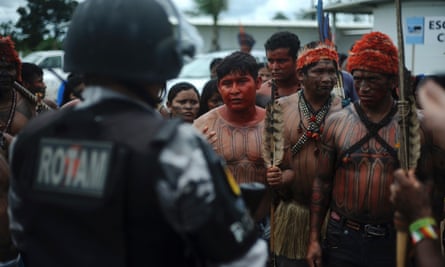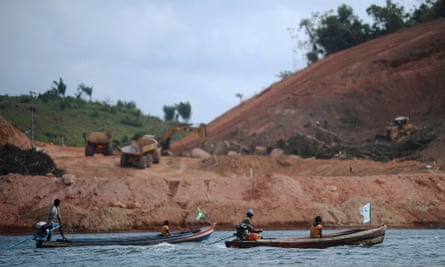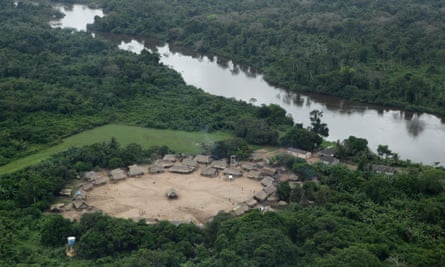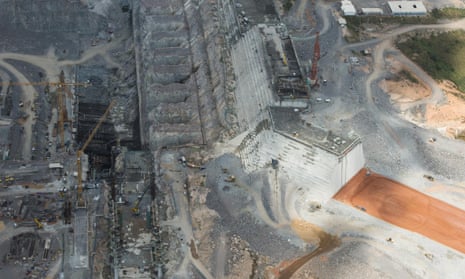By the Great Bend of the Xingu river in the depths of Amazonia, the Juruna tribe is being drowned by what seems at first sight to be a flood of TV game-show prizes.
There’s a shiny new motorboat moored by the old canoe, the latest four-wheel drive parked beside a chicken coop, satellite dishes outside every home and wide-screen plasma TVs inside.
But these are not the spoils of victory. They are the consolations for defeat in an existential battle against Brazil’s biggest engineering project, the Belo Monte dam.
For three decades, the Juruna have been in the vanguard of the fight against the hydroelectric plant – the world’s fourth biggest – which is being built on the edge of their territory in one of the world’s biodiversity hotspots.
The community have marched, lobbied, seized hostages, burned buses and taken to their canoes to try to stop the project. But they have failed.
Next August, the Xingu river will be closed by a 5km-wide dam. The first turbine will come into operation a few months later.
“When they close the river, it will be like they are destroying our lives,” says Giliarde Juruna, the chief of a village in the Paquiçamba indigenous territory. “We have always lived off the river. This region here is where we’ve lived – from our ancestors until today. The impact will be huge.”
Belo Monte is already an undeniable fact. The vast construction site is like something out of Mordor – an immense wall of stone, steel and concrete that towers above a blasted plain teeming with trucks, bulldozers and cranes. The turbine housings, which are half-complete, resemble the jagged ramparts of a fort. Here and there by the side of the road, felled trees are tied up in bundles, like captured prisoners. And as night falls, the usual Amazonian chorus of insects, frogs and birds is drowned out by engines, alarms and clanking earth movers.
Fleets of trucks are shifting 79.2m cubic metres of earth – more than that needed for the Panama canal. To supply the rocks for the barrage, Brazil’s largest pebble crusher has been built nearby. There are also several cement factories to mix the 2.1m cubic metres of concrete that will eventually be poured at the project’s three main sites. There is a main 11,233MW hydroelectric plant at Belo Monte that will house 18 turbines, a secondary much smaller 233MW plant at the 7km barrage across the river in Pimental and a deep canal to divert water from one to the other.

The complex system of this run-of-the-river dam is designed as a low-impact alternative to conventional narrow dams, which simply block the river and build up a huge reservoir behind the dam.
Although Belo Monte will submerge a hefty 478 sq km in its 28-mini reservoirs (in an area that was, until very recently, covered by one the world’s most biodiverse rainforests,) engineers say the ratio of land flooded to power generation is about half that of Brazil’s biggest hydroplant at Itaipu.
At great expense, they say they have designed this 25bn reais hydropower facility to avoid the flooding of indigenous territory. The relatively small reservoir and the maintenance of a minimum flow of water on the trunk river means the plant will work on average at barely 40% of its 11,200MW capacity.

“It’s the price we pay to preserve the environment,” said Jaimie Juraszek, the construction superintendent of Norte Energia. “We cannot save the forest and live in the dark without TV. There is a conflict of interest here. We need balance. I think Belo Monte is a compromise.”
The 20,000 people who will be relocated certainly seems modest compared to the 1.5 million people that China’s government moved for the Three Gorges dam. But, unlike China’s crowded Sichuan province, the problem in sparsely populated Amazonia is not moving people out, but moving them in.
The biggest impact of Belo Monte is from the influx of tens of thousands of construction workers, suppliers, security guards, prostitutes and other migrants who have been drawn to the area by the megaproject. Since work started in 2011, the population of the nearest city of Altamira has surged from about 100,000 to more than 150,000. The newcomers require homes, food, water, electricity, oil, roads and boats – all of which add to the pressure on a local environment that is one of the world’s most important biodiversity hotspots.
Forests are being felled in the Altamira region around the construction site at a faster rate than anywhere else in the country. There are conflicts over fishing catches. Endangered species are under increased pressure and indigenous groups are losing their land and traditions.
Some tribal leaders privately admit that all they are fighting for now is compensation. They want more land and for the dam operator Norte Energia to fulfill its promise to provide them with schools and clinics.
Three years ago, when these were not forthcoming, the government urged the company to launch a two-year “emergency programme” to placate opposition among the Juruna and other indigenous communities.
Suddenly, every wish the tribes made was granted up to a budget of 30,000 reais per village per month. Centuries of a subsistence lifestyle gave way to instant gratification in the form of food, laptops, new vehicles, freezers, motorbikes. For the 2011-13 duration of the programme, all they had to do was ask.
The result was calamitous for traditional customs, hierarchies and a sense of identity. Villages split to get more money. Residents stopped farming and ordered food from the supermarket. Conservative elders were nudged aside by the young who could speak Portuguese with the company officials.
The traditional diet of fish from the river and meat hunted in the forest gave way to barbecued steak and brightly coloured sweets bought at the supermarket. Instead of water from the river, locals drink beer and sweet fizzy drinks. Plastic rubbish is a growing problem.
Outside, respect for the communities is being replaced by scorn or pity. Norte Energia officials are privately contemptuous. “In the old days, you just gave the Indians a mirror and they were happy. Now they want iPads and four-wheel drives,” said one employee.
But it is the company and the government that are to blame, according to the federal prosecutor in Altamira, Thais Santi, who reported with horror her visit to another tribe, the Arara at Cachoeira Seca.

“The scene in the village was that of a post-war holocaust with garbage everywhere,” she said in a recent interview. “The Indians did not move. They just stood there motionless, asking for food, asking to have homes built for them… They had stopped talking and meeting each other. The only time they met was at night to watch a telenovela on a plasma TV. It was brutal … The Emergency Plan had created an absolute dependence on the company.”
Santi said she is now preparing to bring a lawsuit against Belo Monte for “ethnocide against indigenous people”.
Government officials privately acknowledge the “Emergency Plan” should have been better planned. Reversing the damage seems impossible. Many villagers want more land and another “emergency program” of cash payments because, they say, the traditional way of life will soon be impossible and modern appliances, like cars and houses, will be no use without water and food.
The village chief, Juruna tells us he is planning another protest on canoes to try to secure more territory before the dam is completed.
“If they close the river, we’ll never resolve the land issue so we need to fight to stop them. We’ll do whatever it takes. We’ll go there and block it. The police can kill us. I’d rather die there than give up.”
But even the protests are changing the tribe’s way of life, which is now increasingly taken up by meetings. The endless round of talks with government officials, Norte Energia representatives, NGO activists and journalists takes up so much energy that many say they barely have time to tend the land or go fishing.
When they do fish, they say the catches are much lower than in the past because of the blasting and the dust and the extra upstream demand for food for the construction workers.
Conservationists say the situation will get worse when the river is closed off. There are several fish, including the acari, that are unique to the Volta Grande (Big Bend) where the hydropower plant is being constructed. Much of this aquatic life is dependent on the rise and fall of the river. Many species reproduce in flood water ponds that will disappear once the dam is built.

The fluctuation of the Xingu also affects the temperatures of tributaries, which could effect the tracaja turtle. The gender of this species is determined by whether the sand of the banks is hot (female) or cold (male). Reduced flow on the trunk river will mean lower temperatures and probably a higher proportion of males.
It is not only indigenous tribes who are affected. Glio Alvas da Silva has lived on the Xingu for 32 years, but his fishing community of mestizos at São Antonio was one of the first to be disrupted by the project. Before the construction started, he used to spend the night on the river, diving into the depths to catch zebra fish for aquariums, harpooning asas and using wooden traps for pescada. But once the project started, he said the catches started to decline drastically.
“I used to take 50kg each night. Now I’m lucky to get 2kg,” he said. Like many former fishermen in the area, he now makes a living breaking rocks for the dam.
Despite the many tales of woe, Belo Monte is the precursor for more barrages in Amazonia. The government considers hydropower, which accounts for 77% of Brazil’s energy, as the key to meeting the country’s climate commitments while maintaining economic growth. Many of the most accessible rivers are already tapped so future expansion is expected to come from the Amazon and Cerrado regions.
Next year, bidding will start for the next megadam - a 8,000MW plant at São Luiz on the Tapajós river, despite opposition from the Mundruku tribe, whose lands are likely to be partly submerged.
Along with President Dilma Rousseff’s championing of oil and agribusiness, such projects are undermining Brazil’s reputation a global leader on the environment.
In the most recent edition of Science magazine a group of Brazilian scientists warned there was a growing discrepancy between the positive role played by the country’s diplomats at UN climate talks, and the increasingly destructive direction of legislation and infrastructure projects that do not adequately balance environmental and social costs with the economic benefits.

Since 2008, the paper notes that Brazil has lost 44,100 sq km of protected land.
“Until now, unplanned agricultural expansion has been the greatest pressure on the environment, but new pressures are being exerted in response to rising demands for hydropower and mineral resources,” the authors noted. They called for greater investment in solar, wind and biofuels to reduce the destruction this causes.
Environmentalists say the Belo Monte case also highlights the importance of preserving indigenous territory which is home to the last good forests in Brazil. But under existing circumstances, the tribes who have long been the staunchest forest guardians are losing land, culture and the will to resist.
“Belo Monte is gradually weakening them. It’s very sad to see. We’ve been fighting together for 30 years, but now they are succumbing to drugs, drinking and prostitution,” said Antonio Melo, of the Xingu Vivo anti-dam campaign. “Dilma says the dams produce cheap electricity, but the cost is paid here in the destruction of the environment and the destruction of people’s lives.”
- With additional research by Shanna Hanbury

Comments (…)
Sign in or create your Guardian account to join the discussion